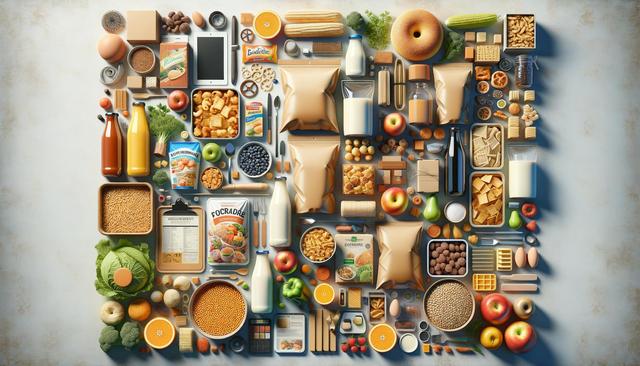Growth Drivers in the Food Packaging Industry
The food packaging industry has seen significant growth over the past few decades, driven by evolving consumer habits, increased demand for convenience, and global food safety standards. As lifestyles become increasingly fast-paced, the need for ready-to-eat and on-the-go food products has surged. This trend directly influences packaging technologies and formats, prompting innovation in materials and design. Moreover, with the expansion of e-commerce, particularly in food delivery services, robust and reliable packaging solutions have become essential to ensure product integrity during transit.
Regulatory compliance is another key element fueling growth in this sector. Governments and international agencies are tightening food safety regulations, which has led to the increased use of packaging that prolongs shelf life and prevents contamination. Technological advancements have also played a crucial role, enabling the development of smart packaging solutions that provide real-time data, such as temperature monitoring and freshness indicators.
Key market drivers include:
- Rising urbanization and changing dietary patterns
- Increased focus on food safety and hygiene
- Technological innovations in biodegradable and smart packaging
- Expansion of global food trade and logistics
Diverse Career and Business Paths
Opportunities in the food packaging industry extend far beyond manufacturing. From research and development to logistics and marketing, there are numerous career and entrepreneurial paths worth exploring. R&D professionals play a vital role in developing new packaging materials that are both functional and eco-friendly. These innovations often require interdisciplinary knowledge in chemistry, material science, and environmental studies.
Another promising area is design and branding. With brands competing for shelf space and consumer attention, packaging designers who can create visually appealing, ergonomic, and informative solutions are in high demand. Meanwhile, logistics and supply chain professionals ensure that the packaging process aligns with distribution needs, minimizing waste and optimizing cost-efficiency.
Business opportunities include:
- Launching a sustainable packaging startup
- Offering specialized packaging design services
- Consulting on regulatory compliance and eco-packaging transitions
- Developing software solutions for packaging process automation
Sustainability and Eco-Friendly Innovations
In response to global environmental concerns, sustainability has become a central theme in food packaging. Companies are under increasing pressure to reduce their ecological footprint, leading to innovative uses of biodegradable, compostable, and recyclable materials. Packaging made from plant-based polymers, mushroom mycelium, and seaweed are gaining traction as alternatives to traditional plastics.
Consumers are also more eco-conscious, and many now consider packaging sustainability as a factor in their purchasing decisions. This shift in consumer behavior has created room for companies to differentiate themselves by adopting green practices. Implementing circular economy principles, such as redesigning packaging for reuse and recyclability, is becoming a competitive advantage.
Key sustainable practices include:
- Switching to renewable material sources
- Reducing packaging material volume through design
- Implementing closed-loop recycling systems
- Using water- or plant-based inks for labeling
Technology Integration and Smart Packaging
Technology is transforming how food packaging functions. Smart packaging, which includes features like QR codes, RFID tags, and temperature-sensitive indicators, adds value for both consumers and suppliers. These technologies not only enhance food safety and shelf-life tracking but also enable better inventory management and supply chain transparency.
For instance, QR codes can be scanned to reveal product origin, nutritional information, or promotions, enhancing customer engagement. Meanwhile, sensors that detect spoilage or temperature fluctuations can alert stakeholders before food safety is compromised. Incorporating these technologies requires collaboration between tech developers, food scientists, and packaging engineers.
Examples of smart packaging applications:
- Time-temperature indicators for perishable items
- Interactive packaging with product traceability
- RFID-enabled inventory tracking for retailers
- Anti-counterfeit features for premium food products
Challenges and Future Outlook
Despite its many opportunities, the food packaging industry also faces several challenges. Cost remains a major concern, especially when adopting sustainable materials or smart technologies. Regulatory complexity across different countries can also pose hurdles for businesses operating globally. Furthermore, managing the environmental impact of packaging waste continues to be an ongoing issue that requires collaborative, systemic solutions.
However, the future of the food packaging industry looks promising with continued investment in R&D, growing consumer awareness, and supportive policy frameworks. Companies that adapt quickly to changing trends and consumer expectations—particularly around sustainability and convenience—are more likely to thrive. Education and upskilling in areas such as materials science, sustainability practices, and packaging design can enhance career prospects for individuals entering the field.
Future trends to watch:
- Increased use of AI and machine learning in packaging automation
- Greater adoption of reusable packaging systems
- Expansion of edible packaging options
- Enhanced focus on lifecycle assessments and carbon footprint reduction
Conclusion: A Dynamic Industry with Room to Grow
The food packaging industry presents a dynamic landscape filled with potential for innovation, entrepreneurship, and career development. Whether you’re a business owner exploring new ventures, a designer curious about sustainable materials, or a technologist interested in smart solutions, this sector offers opportunities across multiple disciplines. As consumer preferences continue to evolve and global demand for safer, greener packaging grows, those who can adapt and innovate will find long-term success in this ever-changing industry.




Leave a Reply